“Surely there is a vein for the silver, and a place for gold where they fine it.”
Cantore Arithmetic is able to give[five] address to Aaron Peskin[District 3] as the comment to the passive aptitude is for Quentin Kopp. To engage a commerce with deference invokes Ross Perot to give the hands that a horse on a ranch would comprehend as a gate.
The width to the tunnel vision on the glasses of coffee to the table of Age is an Era. The word era to generation is known as the beaches of San Francisco. Word era equated fire.
This matter to just the Wall[Walt[Web]] at Ocean Beach while Baker Beach neighbors China Beach is the cliff. The house of reference is left, of course, to The Painted Ladies.
Block to block; the end.
Now, for the so of the issue sounded so rude however the era was a generation and that generation is fact to years. These decades that encumber the success of an already challenged disaster as The Hippie is Steve Jobs by man. To clarify the bounce has been negated thereby there is no ball; the end.
For the Officer that has been announced Morse code is appropriate for Cantore Arithmetic as modern-day physics equated word die.
Shockingly the fraction to the challenge at the word beach grazes the sand to average word sow[Cow], oddly the name by proxy however spelt by dictionary salchow is a figure in Cantore Arithmetic it is the word Continue!! Lets_read: Ulrich Salchow (born August 7, 1877—died April 19, 1949, Stockholm, Sweden) was a Swedish figure skater who established a record by winning 10 world championships for men (1901–05, 1907–11—he did not compete in 1906). At the 1908 Games in London, he won the first Olympic gold medal awarded for men’s figure skating
Quentin Kopp was an American Autonomy and a Martian according to the read and Cantore Arithmetic to the finds, a great wealth. The average to the word is easily retracted that quick is dissolved to mystery as Ave rage. Word rage.
Theses bearings are of candor and the district that places care to beach is of commonwealth. The distance to measure and increase popularity returns to the beaches by known as Quentin equated word Quantum.
To finance ‘Beach grooming’ is a good placement as City Works is able to fail. The beaches in our City are phenomena as the leader of growth is City Works. To charge a live Zoo with what a beach is able to soothe is a preliminary Event and you, Aaron Peskin is the President of the San Francisco Board of Supervisors, representing District 3, has not yet accomplished Pre-training[Novice]. You are negated by distance and hinged by door. Now, word I equated Word floor.
Quentin Kopp had Standards all-inclusive[HORSE] and Standards[Jumps] equated brick. Now, there is another brick in the word Stone.
USEA Classic Series Guidelines
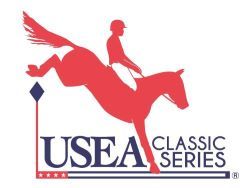
Purpose
History
Guidelines for Education
- How to present your horse at a formal horse inspection (jog practice)
- Supervised steeplechase practice
- Navigating/timing on roads and tracks
- Guide to the vet box
- Endurance day aftercare
- Cross-country and show jumping course walks
Levels and Qualifications
Guidelines for Structure
- Dressage Test
- Cross Country Test is comprised four phases often referred to as Endurance Day:
- Show Jumping Test
Unique Considerations for Roads and Tracks
Attire and Saddlery
Attire and saddlery should be in accordance with the current USEF Rules for Eventing.
Specifications for Levels
Table 1: Classic Three-Day Specifications
Inspection & Examination of Horses
Veterinary Role
Time Calculations & Explanation of Independence of Phases
- On Phases A and C, the time limit is one fifth more than the optimum time.
- On Phase B and D, the time limit is twice the optimum time.
- On Phases A and C, exceeding the optimum time will be penalized at 1.0 penalty point per second.
- On Phase B, exceeding the optimum time will be penalized at the rate of 0.8 penalty point per second.
- On Phase D, exceeding the optimum time is that same as cross-country at Horse Trials. It will be penalized at the rate of 0.4 penalty points per second.
- On Phase B for Beginner Novice, Novice, and Training, each second under the speed fault time will be penalized at 0.4 penalty points per second.
- On Phase D for Beginner Novice, Novice, and Training each second under the speed fault time will be penalized at 0.4 penalty points per second.
Timetable Explanation of Independent Phases
- For example, if the Competitor finishes Phase A 20 seconds late, their break will be only 40 seconds.
- If a Competitor is so late finishing Phase A that he cannot start Phase B on time, he will be started on Phase B as soon as safely possible. The Phase B start will be adjusted to the actual time the starter instructs them to start. This information must be shared with the Controller and Phase D start, as they may need to adjust the Phase D start time accordingly.
- IMPORTANT REMINDER: The optimum time for each subsequent Phase is NOT adjusted. The Competitor who is late finishing any Phase need not attempt to regain the time lost.
Scoring
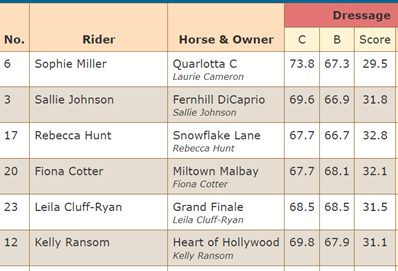
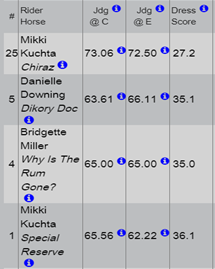
- Phase A – Time Faults
- Phase B (Steeplechase) – Time Faults and Jump Faults including Dangerous Riding
- Phase C – Time Faults
- Phase D (Cross Country) – Time Faults and Jump Faults including Dangerous Riding
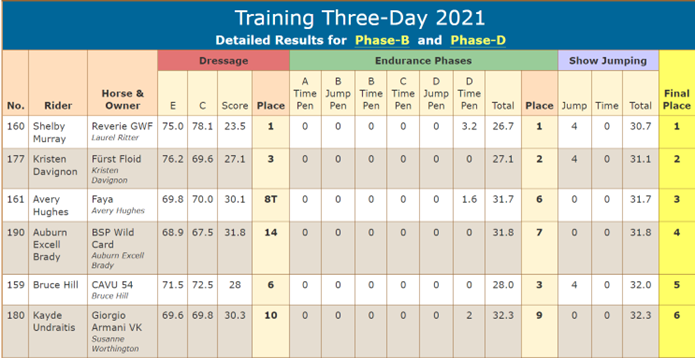
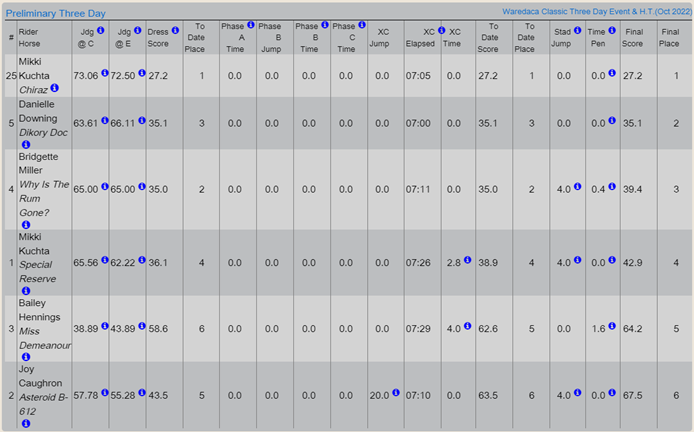
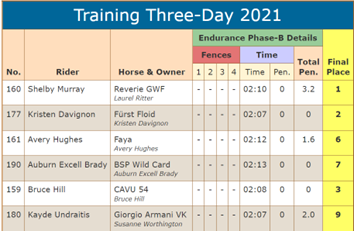
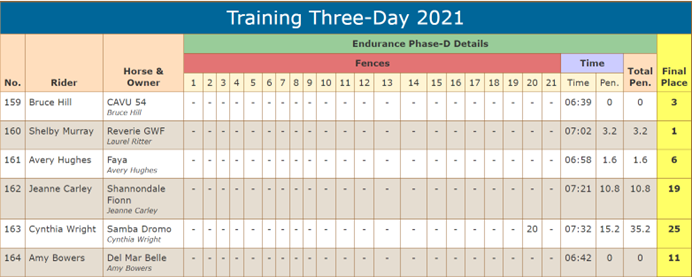
Awards Classification
- The best Phase D score including faults at obstacles, time penalties, and any other penalty that the Competitor may have incurred during cross-country.
- If there is still equality, the classification is decided in favor of the Competitor whose cross-country time was closest to the optimum time.
- If there is still equality, the classification is decided in favor of the Competitor with the best show jumping score including penalties at obstacles and time penalties.
- If there is still equality, the classification is decided in favor of the Competitor with the best collective mark(s) in the dressage test.
- If there is still equality, the tie will remain in the final classification.
Organizers Helpful Hints & Checklist
- Submit request to hosting a Classic Three-Day the same as you do for a Horse Trials.
- Add dressage tests, speeds and distances for Phases A, B, and C to your Omnibus listing
- Decide if you will use more than one judge for the dressage. Many Classic Series events do and so both will officiate at the horse inspections.
- Consider hiring at least one Official with Classic Series experience.
- Determine if your Veterinarian has experience with a Classic format.
- Hire additional staff to support the Veterinarian. They will assist with the arrival exams, the horse inspection and the ten-minute box.
- Determine if your cross-country Course Designer will design or if someone else will layout Phases A, B and C.
- Determine if you will need an additional Farrier(s) for endurance day. They should be located close to the assistance area
- Determine who will help conduct the clinics and education sessions
- Create a rough outline of the education schedule to fit with the competition schedule
- Communicate with your Competitors on things such as what time to arrive for In-Barn (arrival) Exams and what paperwork they will need. Some events require the Coggins test, health certificates, etc. based on the state’s requirements.
- Post or link to any educational sites available.
- Locate an area close to the barns or determine if the Veterinarians will come to the stalls
- Provide a table & chairs for the staff doing the in barns
- If using a central place for these exams, provide shelter for inclement weather
- Determine if the Veterinarian will need a scribe
- Provide the Veterinarians with inspection sheets (included in this guide) with at least the horse’s competition number, name and stall number included. These sheets will follow the horse throughout the Horse Inspections and the vet box. First and Third Horse Inspections:
- Locate a suitable place to hold the horse inspections. Ideally, it should:
- Be a level, firm surface that will not get slippery. Limestone can be sprinkled on pavement to keep horses from slipping.
- Be close to the stables
- Be at least 20 meters long (no longer than 50 meters)
- Lined with plants with a ‘turnaround’ marker at the end
- Often, a small tent is provided for the officials with a table and chairs
- Provide an area removed from the crowd for the holding area where a horse may be examined for soundness.
- Provide a PA and Announcer if possible.
- Determine order of go and provide to Officials and Competitors.
- Determine if Competitors with more than one horse in the level will be allowed to present back-to-back.
- You will need to provide:
- Determine arena sizes needed
- If possible, provide a test ride if you are using multiple judges to judge a class
- If using multiple judges, ask if they want a radio between them during the class
- Copy the additional sets of tests if using multiple judges
- Set additional judges booths for extra judges
- Ensure your scorers know how to score using multiple judges (EV136.3)
- Be sure you understand the relationship of all the phases with regards to timing and scoring. (EV156.6 & EV156.7) (page 10)
- Provide a map of Phases A, B and C with flagged and numbered gates and kilometer markers
- Provide a timetable, showing all of the start and finish times for each phase, to each Competitor, Official, Timer, Starter and anyone else who will need to know the entire schedule of the day. (pages 12-13).
- Locate an area for the assistance area.
- Locate the ten-minute box.
- Confirm with your Veterinarian delegate that all arrangements, timing plans and traffic patterns are set.
- Ideally the vet box and the D recovery box should be close to each other for easy access to the cooling teams.
- A reliable source of water is vital. A hose or a water truck is recommended. Know how long it takes to fill the truck and
return. - In hot weather, the ten-minute box should be shaded if possible
- Provide a central area with table, chairs and a pop-up tent, if possible, for the Veterinarians
- Provide multiple large water troughs and ample water supply in both the ten-minute box and the D recovery box
- Decide if you can provide ice for free. If not, try to have ice on hand for Competitors to buy.
- Ice (provided by the event) should be put in the troughs, in their bags, to maximize cooling the water. Quantity depends
on the weather and size of troughs. 100 – 150-gallon troughs cool more quickly than larger ones but need filling more
often. - Appoint someone who will be responsible for keeping the troughs full and cold.
- When determining the start of the show jumping phase, allow enough time for all Officials and Competitors to complete the third horse inspection. The Officials might need to approve the course. Competitors will need time to change into riding attire and tack up. Allow enough time for them to walk the course, if it was not open prior to the horse inspection.
- Inform Competitors, Officials, Scorers, and Show Jumping Crew if you plan to run in reverse order of go.
- Determine if you will award Cours Complet ribbons or tokens.
- Determine what type of award ceremony you will host.
- Be sure to brief your scorers on the differences in scoring a Classic Series event well in advance of the competition.
- You may need additional scorers to help with the Classic phases.
- You will need additional personnel for endurance day:
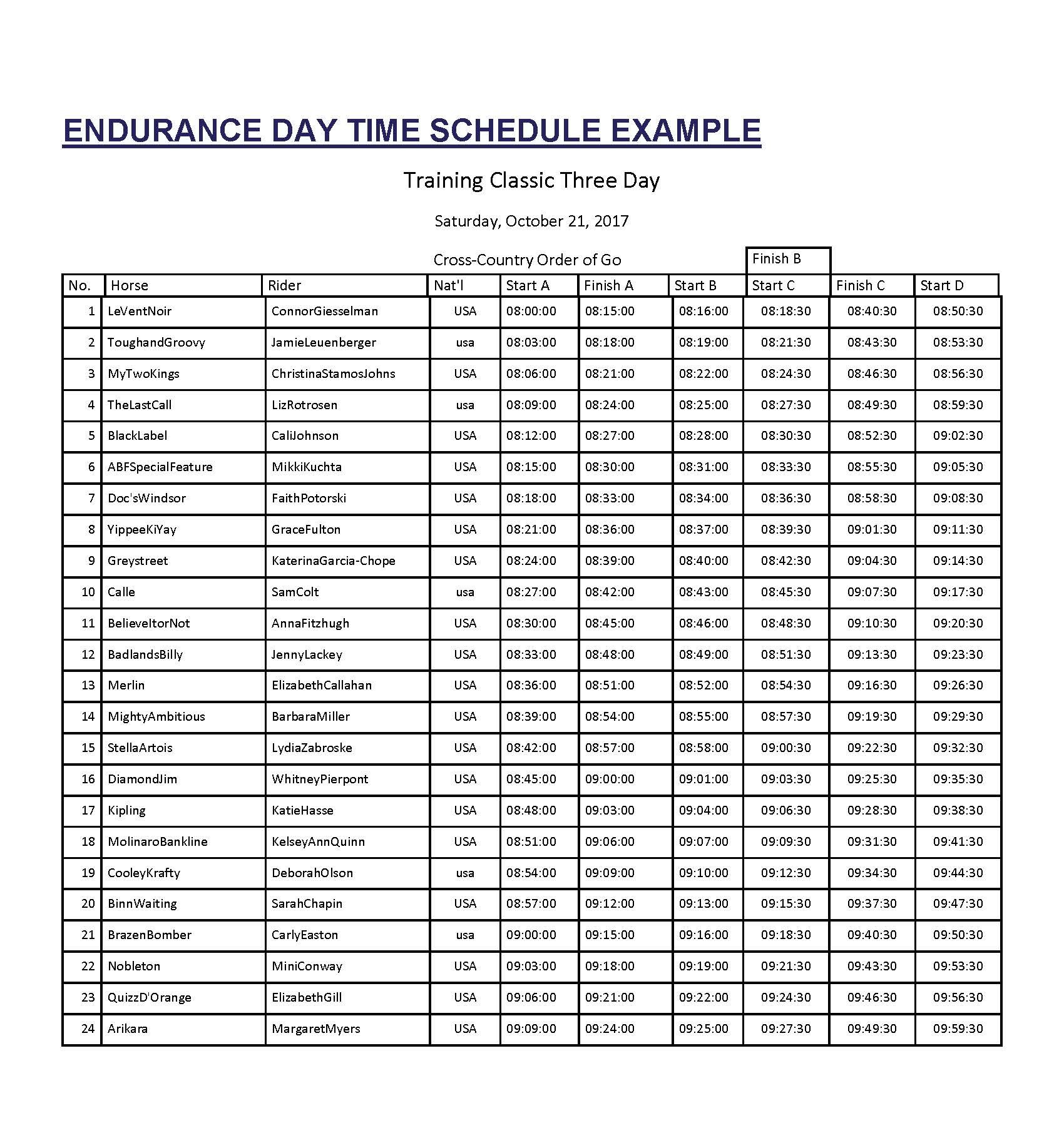
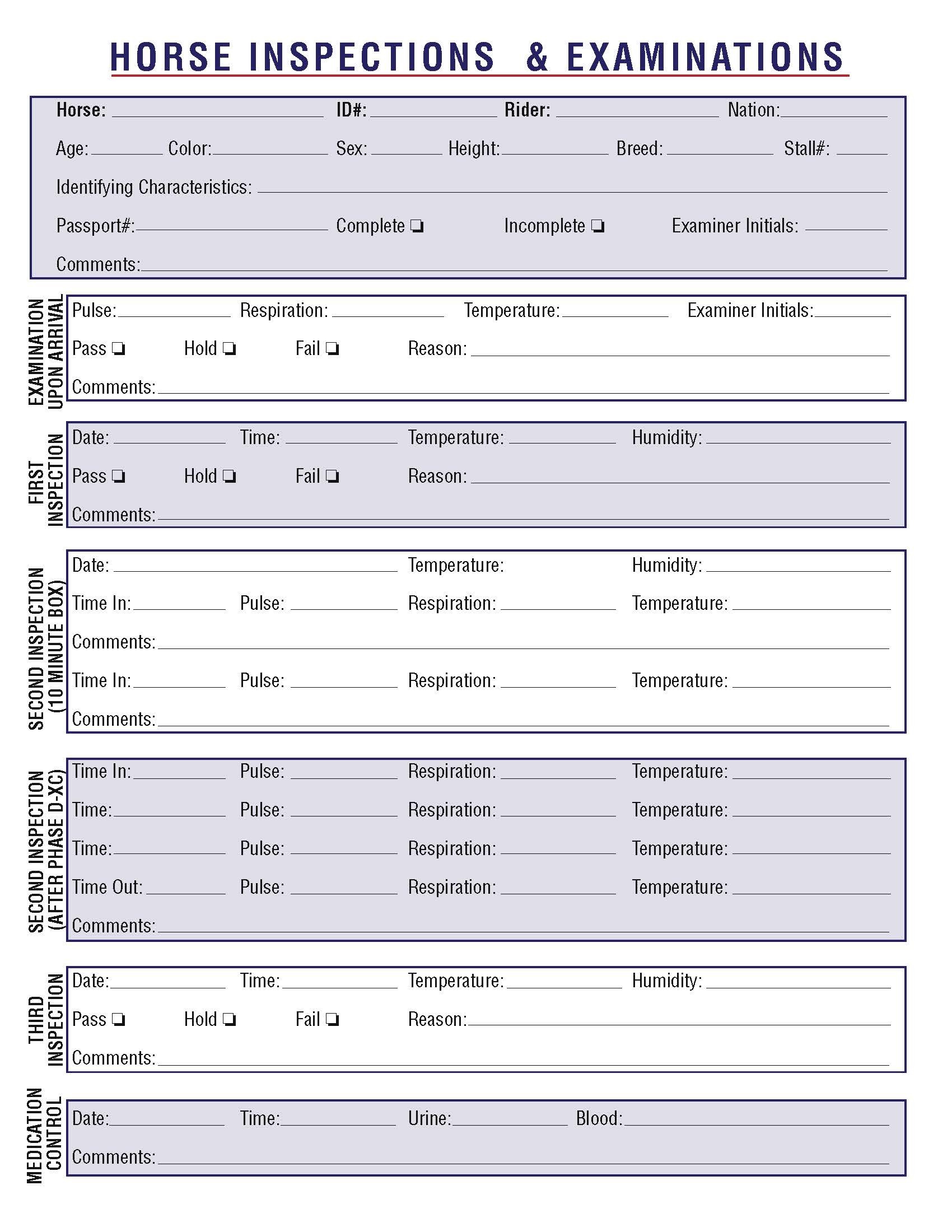
You searched for
"FLOOR" in the KJV Bible
18 Instances - Page 1 of 1 - Sort by Book Order - Feedback
- 1 Kings 6:15chapter context similar meaning copy save
- And he built the walls of the house within with boards of cedar, both the floor of the house, and the walls of the cieling: and he covered them on the inside with wood, and covered the floor of the house with planks of fir.
- 1 Kings 6:30chapter context similar meaning copy save
- And the floor of the house he overlaid with gold, within and without.
- Ruth 3:6chapter context similar meaning copy save
- And she went down unto the floor, and did according to all that her mother in law bade her.
- Isaiah 21:10chapter context similar meaning copy save
- O my threshing, and the corn of my floor: that which I have heard of the LORD of hosts, the God of Israel, have I declared unto you.
- Micah 4:12chapter context similar meaning copy save
- But they know not the thoughts of the LORD, neither understand they his counsel: for he shall gather them as the sheaves into the floor.
- 1 Kings 7:7chapter context similar meaning copy save
- Then he made a porch for the throne where he might judge, even the porch of judgment: and it was covered with cedar from one side of the floor to the other.
- 2 Chronicles 34:11chapter context similar meaning copy save
- Even to the artificers and builders gave they it, to buy hewn stone, and timber for couplings, and to floor the houses which the kings of Judah had destroyed.
- Hosea 9:2chapter context similar meaning copy save
- The floor and the winepress shall not feed them, and the new wine shall fail in her.
- Ruth 3:14chapter context similar meaning copy save
- And she lay at his feet until the morning: and she rose up before one could know another. And he said, Let it not be known that a woman came into the floor.
- Genesis 50:11chapter context similar meaning copy save
- And when the inhabitants of the land, the Canaanites, saw the mourning in the floorof Atad, they said, This is a grievous mourning to the Egyptians: wherefore the name of it was called Abelmizraim, which is beyond Jordan.
- Matthew 3:12chapter context similar meaning copy save
- Whose fan is in his hand, and he will throughly purge his floor, and gather his wheat into the garner; but he will burn up the chaff with unquenchable fire.
- Luke 3:17chapter context similar meaning copy save
- Whose fan is in his hand, and he will throughly purge his floor, and will gather the wheat into his garner; but the chaff he will burn with fire unquenchable.
- Hosea 13:3chapter context similar meaning copy save
- Therefore they shall be as the morning cloud, and as the early dew that passeth away, as the chaff that is driven with the whirlwind out of the floor, and as the smoke out of the chimney.
- Judges 6:37chapter context similar meaning copy save
- Behold, I will put a fleece of wool in the floor; and if the dew be on the fleece only, and it be dry upon all the earth beside, then shall I know that thou wilt save Israel by mine hand, as thou hast said.
- Ruth 3:3chapter context similar meaning copy save
- Wash thyself therefore, and anoint thee, and put thy raiment upon thee, and get thee down to the floor: but make not thyself known unto the man, until he shall have done eating and drinking.
- Deuteronomy 15:14chapter context similar meaning copy save
- Thou shalt furnish him liberally out of thy flock, and out of thy floor, and out of thy winepress: of that wherewith the LORD thy God hath blessed thee thou shalt give unto him.
- 1 Kings 6:16chapter context similar meaning copy save
- And he built twenty cubits on the sides of the house, both the floor and the walls with boards of cedar: he even built them for it within, even for the oracle, even for the most holy place.
- Numbers 5:17chapter context similar meaning copy save
- And the priest shall take holy water in an earthen vessel; and of the dust that is in the floor of the tabernacle the priest shall take, and put it into the water:














No comments:
Post a Comment